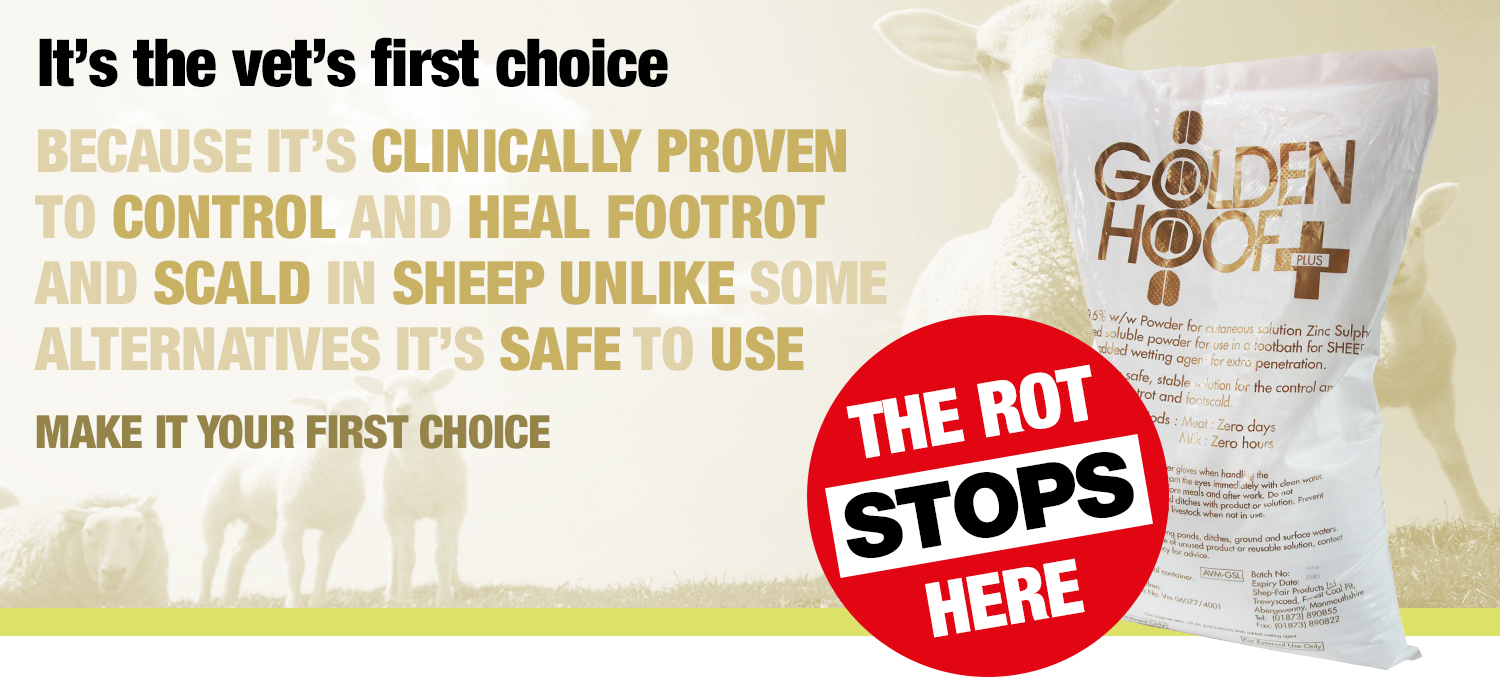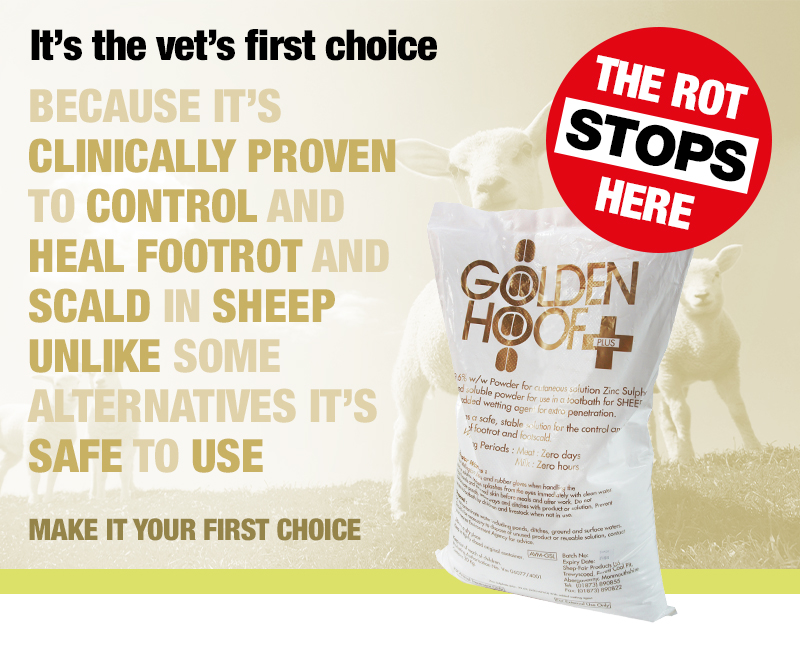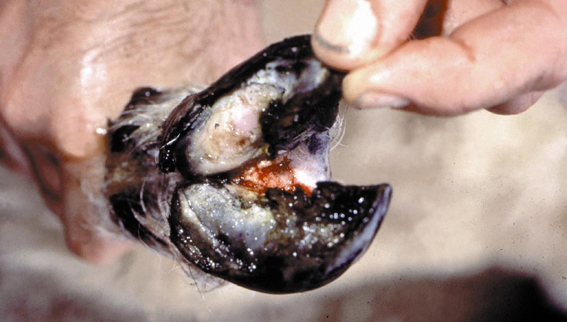





Footrot is a highly contagious disease commonly found in sheep, goats and cattle. While some breeds are more susceptible than others, and some strains more virulent than others, it is non the less one of the most serious diseases affecting cloven-hoofed livestock today.
Footrot is highly infectious, with the bacteria able to survive on pasture for up to 12 days. It is most prevalent between April and June, and August and October, in warm, wet conditions. Temperatures of above 10C are optimal for the bacteria to thrive.

Foot scald is caused when sheep are exposed to wet conditions underfoot, such as wet bedding and poached fields, and can occur at any time of year to any breed.
Both diseases are caused by the bacteria Fusobacterium necrophorum which invades the area where the skin joins the hoof, and cause damage to the skin. Foot scald causes the skin to become red and inflamed, and the sheep to become lame. In the case of Footrot, the bacteria Dichlobacter nodosus enters through the already damaged skin and continues into the foot, where it may cause the hoof to separate completely, resulting in severe pain, a smelly discharge and lameness.
Once Footrot has presented in one animal, all the animals in the flock must be treated whether they are showing signs or not. Those with the disease may require topical antibiotics and significant paring of the infected area to both remove and expose the bacteria. On occasion, it may be necessary to cull animals that show resistance to treatment methods, as they will continually re-infect the pasture.
Mild cases of foot scald can be treated with an appropriate spray, but where several animals are affected, a footbath is more effective.
What every farmer needs to know. We all accept that certain dangers are integral in farming, but choosing to use a known cancer causing product doesn’t need to be one of them.

Let’s face it we’ve all known it for years that formaldehyde is nasty stuff. But just how nasty is now a lot clearer. As of 1st January 2016, formaldehyde (formalin) has been officially reclassified as a Category 1B carcinogen, meaning that research has shown it to cause cancer. Formaldehyde can now only be sold by registered suppliers, and only be used by professionals. As farmers you are professionals, but is it worth the risk?
What are the risks?
We know farming comes with inherent risks, but as a farmer you have a duty of care to your staff to provide a safe and suitable working environment. Of course it is usually not just staff who are on your family farm, so you also need to consider the potential risks if children and family are around. Not to mention the sheep themselves. If they could speak, your flock would tell you of the painful stinging sensation that formaldehyde has on any sensitive tissue.
So isn’t it time to make a safer choice for yourself, your staff, your family and your flock?
That said, choosing an alternative also comes with risks. Footrot is an extremely painful, highly contagious disease with serious animal welfare implications if not treated quickly and effectively. Not to mention the risk of avoidable vet’s bills, which nobody welcomes. So choosing an alternative to formaldehyde should not be taken lightly, and going for the cheap and cheerful option may ultimately prove to be the costliest approach.
What’s the alternative?
Copper or zinc sulphate are popular alternatives, but is there much to choose between them and how do you know which of the many products available will work for your flock?
Copper sulphate is well known in footbaths but has no proven, licensed products in the UK. What research there is seems to be flawed, leaving the efficacy unproven. By comparison the antiseptic action of zinc sulphate has a long history of being well researched, with a number of studies to support its use. One study in particular found bathing in a zinc sulphate and surfactant blend to be just as effective against footrot as formalin, with no noticeable difference between results from the two treatments. Unlike copper sulphate, zinc is used in UK licensed products which have had to prove their effectiveness before a license could be granted.
However one thing we do know is that zinc is poorly absorbed across the skin and hoof - so is zinc alone the best approach? For optimum efficacy it’s important we ensure the action of the zinc is maximised where it’s needed most. For this reason Golden Hoof Plus*, a high strength zinc sulphate compound, includes crucial excipients that work as a vehicle for the active ingredient, ensuring efficacy on the hoof. Golden Hoof Plus is the only licensed, veterinary authorised zinc blend with proven efficacy for the control and healing of footrot and footscald in your flock.
Of course efficacy is all very well, but if it’s going to be a hassle to use, it’s just one more challenge that you don’t need. Golden Hoof Plus is formulated to be easy to mix, and certainly the feedback from farmers would seem that those using Golden Hoof definitely agree. Golden Hoof Plus powder mixes easily with water into solution, and treatment times start at just a couple of minutes standing in the footbath with a fast dry (min. 15 mins) on hard standing before returning to grass.
Last but not least, for the modern farming business Golden Hoof Plus is also a cost effective alternative. With a pack price a fraction of the cost of some of its zinc or copper competitors, Golden Hoof Plus is the ideal starting point when making the change from formalin.
Golden Hoof Plus has proven efficacy, is easy to use and represents excellent value for money. With no withdrawal periods for either meat or milk, and having hoof hardening properties Golden Hoof Plus is the ideal choice to replace formaldehyde on your farm.



